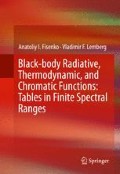Abstract
The devices which are dealing with the thermal radiation (such as emitters [1–4], receivers [5–8], filters [9–12], transformers [13–15], etc.) are mainly working in a finite range of frequencies. Such devices are frequently need to be optimized for getting the best possible value for the specific thermal radiative or thermodynamic characteristics that can be reached in the given spectral range. For example, the devices can be optimized for obtaining the maximal possible amount of the emitted (or received) total radiation energy, or, alternatively, the maximal number of the emitted (or received) number of photons. Potentially, the devices can be also optimized for some other thermal radiative or thermodynamic parameters.
Access this chapter
Tax calculation will be finalised at checkout
Purchases are for personal use only
References
T. Matsumoto, T. Makoto, Opt. Express 18(102), A192 (2010)
C.H. Chao, C.F. Lin, Enhance the blue-light emission of black-body radiation with metallic photonic boxes, in Proceedings of 5th IEEE Conference on Nanotechnology, Nagoya, Japan, July 2005, pp. 382–385
H. Sai, K. Yoshiaki, Y. Hiroo, Appl. Phys. Lett. 82, 1685 (2003)
J.J. Greffet et al., Nature 416, 61 (2002)
A. Rogalski, Infrared Detectors, 2nd edn. (CRC press, Hoboken, 2010), p. 898
E.L. Dereniak, G.D. Boreman, Infrared Detectors and Systems (Wiley, Hoboken, 1996), p. 592
S.R. Wenham, Applied Photovoltaics, 3rd edn. (Routledge, Abingdon, 2012), p. 304
M. Green, Third Generation Photovoltaics: Advanced Solar Energy Conversion, 2nd edn. (Springer, Berlin, 2005), p. 160
A.D. Brown et al., LPI Contributions 1683, 1107 (2012)
D.W. Porterfield et al., Appl. Opt. 33(25), 6046 (1994)
T. Bauer, M. Lappschies, U. Schallenberg, S. Jakobs, Manufacturing and characterizing of all-dielectric band-pass filters for the short-wave infrared region, in SPIE Optical Systems Design (International Society for Optics and Photonics, 2011), p. 81680Z
T. Borne et al., Interference filters for thermo-photovoltaic applications (1999). [Study Group Report]. http://www.maths-in-industry.org/miis/view/year/1999.type.html
I. Celanovic, B. Peter, S. Marin, Invitied Review Article in Oyo Buturi (Japan Society of Applied Physics) 80(8), 6 (2011)
Y.X. Yeng et al., Enabling high-temperature nanophotonics for energy applications. Proc. Natl. Acad. Sci. 109(7), 2280 (2012)
R. St-Gelais et al., Demonstration of strong near-field radiative heat transfer between integrated nanostructures. Nano Lett. 14(12), 6971 (2014)
S.M. Nikol’skii, Course of Mathematical Analysis (Central Books Ltd, London, 1978), p. 900
T.M. Apostol, Calculus Vol. 1: One-Variable Calculus with an Introduction to Linear Algebra, 2nd edn. (Wiley, New York, 1991), p. 666
L.D. Landau, E.M. Lifshitz, Statistical Physics, Course of Theoretical Physics, vol. 5 (Pergamon Press, Oxford, New York, 1980), p. 484
W. Kaplan, Advanced Calculus, 5th edn. (Pearson, Boston, 2002), p. 736
H. Flanders, Differentiation under the integral sign. Am. Math. Mon. 80(6), 615 (1973)
L. Shichun, L. Fei, S. Xiu’e, Infrared Phys. 29(24), 205 (1989)
L. Shichun, L. Fei, Infrared Phys. 32, 245 (1991)
W. Zhigang, Infrared Phys. 33(4), 313 (1992)
L. Shichun, L. Fei, Proc. SPIE 2245, 296 (1994)
T. Fang, Int. Commun. Heat Mass Transfer 30(1), 47 (2003)
S.M. Stewart, R.B. Johnson, Exact expressions for thermal contrast detected with thermal and quantum detectors, in SPIE Security + Defence (International Society for Optics and Photonics, 2014), pp. 92490D
Author information
Authors and Affiliations
Rights and permissions
Copyright information
© 2016 Springer International Publishing Switzerland
About this chapter
Cite this chapter
Fisenko, A.I., Lemberg, V.F. (2016). Optimization Problems for the Devices Using the Black-Body Thermal Radiation. In: Black-body Radiative, Thermodynamic, and Chromatic Functions: Tables in Finite Spectral Ranges. Springer, Cham. https://doi.org/10.1007/978-3-319-38995-0_5
Download citation
DOI: https://doi.org/10.1007/978-3-319-38995-0_5
Published:
Publisher Name: Springer, Cham
Print ISBN: 978-3-319-38994-3
Online ISBN: 978-3-319-38995-0
eBook Packages: EnergyEnergy (R0)

